Chapter 5: Make or buy and other short-term decisions
Chapter learning objectives
Upon completion of this chapter you will be able to:
- explain the practical issues surrounding make versus buy and outsourcing decisions
- for given data, calculate and compare 'make' costs with 'buy-in' costs
- for given data, compare in-house costs and outsource costs of completing tasks and consider other issues surrounding this decision
- for given data, apply relevant costing principles in situations involving make or buy, shut down, one-off contracts and joint product further processing decisions.
1 Introduction
This chapter will focus on a number of short-term decisions that are typically made by a business:
- Make versus buy decisions
- Shut-down decisions
- One-off contract decisions
- Further processing decisions
Each of these decisions is based on relevant costing principles.Therefore, a recap of relevant costing will be useful before looking ateach of the decisions in turn.
2 Relevant costs and revenues
Decision making involves making a choice between two or morealternatives. The decision will be ‘rational'; profit maximising. Alldecisions will be made using relevant costs and revenues.
‘Relevant costs are future cash flows arising as a direct consequence of the decision under consideration.'
There are three elements here:
Cash flows. To evaluate a decision, actual cash flows shouldbe considered. Noncash items such as depreciation and interdivisionalcharges should be ignored.
Future costs and revenues. This means that past costs andrevenues are only useful insofar as they provide a guide to the future.Costs already spent, known as sunk costs, are irrelevant for decisionmaking.
Differential costs and revenues. Only those costs andrevenues that alter as a result of a decision are relevant. Wherefactors are common to all the alternatives being considered they can beignored; only the differences are relevant.
In many short-term situations, the fixed costs remain constant foreach of the alternatives being considered and thus the marginal costingapproach showing sales, marginal cost and contribution is particularlyappropriate.
In the long run (and sometimes in the short run) fixed costs dochange and accordingly the differential costs must include any changesin the amount of fixed costs.

 Relevant costs
Relevant costs
Test your understanding of relevant and non-relevant costs byseeing if you can identify which of the following costs are relevant :
(a) The salary to be paid to a marketresearcher who will oversee the development of a new product. This is anew post to be created specially for the new product but the £12,000salary will be a fixed cost. Is this cost relevant to the decision toproceed with the development of the product?
(b) The £2,500 additional monthlyrunning costs of a new machine to be purchased to manufacture anestablished product. Since the new machine will save on labour time, thefixed overhead to be absorbed by the product will reduce by £100 permonth. Are these costs relevant to the decision to purchase the newmachine?
(c) Office cleaning expenses of £125for next month. The office is cleaned by contractors and the contractcan be cancelled by giving one month's notice. Is this cost relevant to adecision to close the office?
(d) Expenses of £75 paid to themarketing manager. This was to reimburse the manager for the cost oftravelling to meet a client with whom the company is currentlynegotiating a major contract. Is this cost relevant to the decision tocontinue negotiations?

3 Opportunity cost
Opportunity cost is an important concept for decision-makingpurposes. It is the value of the best alternative that is foregone when aparticular course of action is undertaken. It emphasises that decisionsare concerned with choices and that by choosing one plan, there maywell be sacrifices elsewhere in the business.

 Test your understanding 1 - Opportunity cost
Test your understanding 1 - Opportunity cost
A company which manufactures and sells one single product iscurrently operating at 85% of full capacity, producing 102,000 units permonth. The current total monthly costs of production amount to£330,000, of which £75,000 are fixed and are expected to remainunchanged for all levels of activity up to full capacity.
A new potential customer has expressed interest in taking regularmonthly delivery of 12,000 units at a price of £2.80 per unit.
All existing production is sold each month at a price of £3.25 perunit. If the new business is accepted, existing sales are expected tofall by 2 units for every 15 units sold to the new customer.
What is the overall increase in monthly profit which would result from accepting the new business?

4 The relevant cost of materials
Any historic cost given for materials is always a sunk cost and never relevant unless it happens to be the same as the current purchase price.
5 The relevant cost of labour
6 Make versus buy
Making the decision on financial grounds
A product should be made in-house if the relevant cost of makingthe product in-house is less than the cost of buying the productexternally.
Spare capacity exists
Unless stated otherwise in the question, it should be assumed that there is spare capacity.

No spare capacity exists


 Illustration 1 - Make or buy
Illustration 1 - Make or buy
A factory's entire machine capacity is used to produce essentialcomponents. The production costs of using the machines are as follows.

If all component production was outsourced, then the machines couldbe used to produce other items that would generate additionalcontribution of $50,000. Assume the fixed costs will still be incurredif production is outsourced.
What is the maximum price that the company should be willing to pay to the outside supplier for the components?


 Solution
Solution



 Test your understanding 2
Test your understanding 2
Robust Ltd makes four components A, B, C and D and the associated annual costs are as follows:
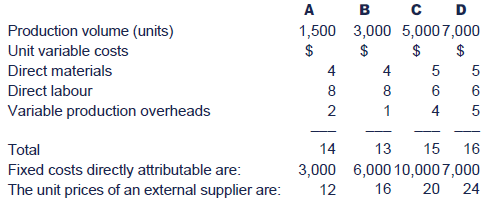
Determine whether any of the components should be bought in from the external supplier.

Other issues to consider
In addition to the relative cost of buying externally compared tomaking in-house, management must consider a number of other issuesbefore a final decision is made.
- Reliability of external supplier: can the outside company be relied upon to meet the requirements in terms of:
- quantity required
- quality required
- delivering on time
- price stability
- Specialist skills: the external supplier may possess some specialist skills that are not available in-house.
- Alternative use of resource: outsourcing will free up resources which may be used in another part of the business.
- Social: will outsourcing result in a reduction of the workforce? Redundancy costs should be considered.
- Legal: will outsourcing affect contractual obligations with suppliers or employees?
- Confidentiality: is there a risk of loss of confidentiality, especially if the external supplier performs similar work for rival companies.
- Customer reaction: do customers attach importance to the products being made in-house?

 Test your understanding 3 - Additional question on make vs buy
Test your understanding 3 - Additional question on make vs buy
KRS Ltd is considering whether to administer its own purchaseledger or to use an external accounting service. It has obtained thefollowing cost estimates for each option:
Internal service department


Determine the cost effectiveness of outsourcing the accounting activities and identify the qualitative factors involved.

7 Shut-down decisions
Part of a business, for example a department or a product, mayappear to be unprofitable. The business may have to make a decision asto whether or not this area should be shut down.
The quantifiable cost or benefit of closure
The relevant cash flows associated with closure should be considered. For example:
- the lost contribution from the area that is being closed (= relevant cost of closure)
- savings in specific fixed costs from closure (=relevant benefit of closure)
- known penalties and other costs resulting from the closure, e.g. redundancy, compensation to customers (=relevant cost of closure)
- any known reorganisation costs (= relevant cost of closure)
- any known additional contribution from the alternative use for resources released (= relevant benefit of closure).
If the relevant benefits are greater than the relevant costs ofclosure then closure may occur. However, before a final decision is madethe business should also consider the non-quantifiable factorsdiscussed below.
Non-quantifiable costs and benefits of closure
- Some of the costs and benefits discussed above may be non-quantifiable at the point of making the shut-down decision:
- penalties and other costs resulting from the closure (e.g. redundancy, compensation to customers) may not be known with certainty.
- reorganisation costs may not be known with certainty.
- additional contribution from the alternative use for resources released may not be known with certainty
- Knock-on impact of the shut-down decision. For example, supermarkets often stock some goods which they sell at a loss. This is to get customers through the door, who they then hope will purchase other products which have higher profit margins for them. If the decision is taken to stop selling these products, then the customers may no longer come to the store.

 Test your understanding 4
Test your understanding 4
The management of Fiona Co is considering the closure of one of itsoperations, department 3, and the financial accountant has submittedthe following report.
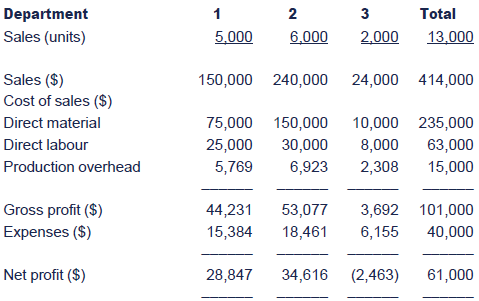
Additional information:
- production overheads of $15,000 have been apportioned to the three departments on the basis of unit sales volume
- expenses are head office overheads, again apportioned to departments on sales volume.
As management accountant, you further ascertain that, on a cost driver basis:
- 50% of the production overheads can be directly traced to departments and so could be allocated on the basis 2:2:1.
- Similarly 60% of the expenses can be allocated 3:3:2, with the remainder not being possible to allocate.
- 80% of the so-called direct labour is fixed and cannot be readily allocated. The remaining 20% is variable and can be better allocated on the basis of sales volume.
(a) Restate the financial position interms of the contribution made by each department and, based on thesefigures, make a clear recommendation.
(b) Discuss any other factors that should be considered before a final decision is made.


 Additional example on shut-down decisions
Additional example on shut-down decisions
Harolds fashion store comprises three departments – Men's Wear, Ladies' Wear and Unisex. The store budget is as follows:
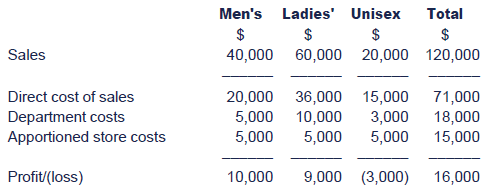
It is suggested that Unisex be closed to increase the size of Men's and Ladies' Wear.
Required:
Determine what information is relevant or required.
Solution
Possible answers are as follows:
(a) Unisex earns $2,000 net contribution (apportioned costs will still be incurred and thus reapportioned to other departments).
(b) Possible increase in Men's/Ladies' sales volume.
(c) Will Unisex staff be dismissed or transferred to Men's/Ladies'?
(d) Reorganisation costs, e.g. repartitioning, stock disposal.
(e) Loss of custom because Unisex attracts certain types of customer who will not buy in Men's/Ladies'.

8 One-off contracts
When a business is presented with a one-off contract, it shouldapply relevant costing principles to establish the cash flows associatedwith the project.
The minimum contract price = the total of the relevant cash flows associated with the contract.
If the contract price does not cover these cash flows then it should be rejected.

 Test your understanding 5
Test your understanding 5
Mr Smith has been asked to quote a price for a special contract. Hehas already prepared his tender but has asked you to review it for him.
He has pointed out to you that he wants to quote the minimum priceas he believes this will lead to more lucrative work in the future.
Mr Smith's tender

Other information
Material A
- 1,000 kgs of this material is in stock at a cost of $5 per kg.
- Mr Smith has no alternative use for his material and intends selling it for $2 per kg.
- However, if he sold any he would have to pay a fixed sum of $300 to cover delivery costs.
- The current purchase price is $10 per kg.
Material B
- There is plenty of Material B in stock and it cost $18 per kg.
- The current purchase price is $15 per kg.
- The material is constantly used by Mr Smith in his business.
Material C
- The total amount in stock of 500 kgs was bought for $10,000 some time ago for another one-off contract that never happened.
- Mr Smith is considering selling it for $6,000 in total or using it as a substitute for another material, constantly used in normal production.
- If used in this latter manner it would save $8,000 of the other material.
- Current purchase price is $40 per kg.
Material D
- There are 100 litres of this material in stock.
- It is dangerous and if not used in this contract will have to be disposed of at a cost to Mr Smith of $50 per litre.
- The current purchase price is $12 per litre.
Skilled labour
- Mr Smith only hires skilled labour when he needs it.
- $25 per hour is the current hourly rate.
Semi-skilled labour
- Mr Smith has a workforce of 50 semi-skilled labourers who are currently not fully utilised.
- They are on annual contracts and the number of spare hours currently available for this project are 1,500. Any hours in excess of this will have to be paid for at time-and-a-half.
- The normal hourly rate is $15 per hour.
Unskilled labour
- These are currently fully employed by Mr Smith on jobs where they produce a contribution of $2 per unskilled labour hour.
- Their current rate is $10 per hour, although extra could be hired at $20 an hour if necessary.
Fixed overheads
- This is considered by Mr Smith to be an accurate estimate of the hourly rate based on his existing production.
Costs of preparing the tender
- Mr Smith has spent 10 hours working on this project at $100 per hour, which he believes is his charge-out rate.
- Other expenses include the cost of travel and research spent by Mr Smith on the project.
Profit
- This is Mr Smith's minimum profit margin which he believes is necessary to cover 'general day-to-day expenses of running a business'.
Required:
Calculate and explain for Mr Smith what you believe the minimum tender price should be.


 Additional example on one-off contracts
Additional example on one-off contracts
A research contract, which to date has cost the company $150,000, is under review.
If the contract is allowed to proceed:
- it will be completed in approximately one year
- the results would then be sold to a government agency for $300,000.
Shown below are the additional expenses which the managing director estimates will be necessary to complete the work.
Materials
- This material for the contract has just been purchased at a cost of $60,000.
- It is toxic; if not used in this contract it must be disposed of at a cost of $5,000.
Labour
- Skilled labour is hard to recruit.
- The workers concerned were transferred to the contract from a production department, and at a recent meeting, the production manager claimed that if the men were returned to him they could generate sales of $150,000 in the next year.
- The prime cost of these sales would be $100,000, including $40,000 for the labour cost itself.
- The overhead absorbed into this production would amount to $20,000.
Research staff
- It has been decided that when work on this contract ceases, the research department will be closed.
- Research wages for the year are $60,000, and redundancy and severance pay has been estimated at $15,000 now, or $35,000 in one year's time.
Equipment
- The contract utilises a special microscope which cost $18,000 three years ago.
- It has a residual value of $3,000 in another two years, and a current disposal value of $8,000.
- If used in the contract it is estimated that the disposal value in a year's time will be $6,000.
Share of general building services
- The contract is charged with $35,000 pa to cover general building expenses.
- Immediately after the contract is discontinued, the space occupied could be sub-let for an annual rental of $7,000.
Required:
Advise the managing director as to whether the contract should beallowed to proceed, explaining the reasons for the treatment of eachitem.
(Note: Ignore the time value of money.)

Advice. Proceed with the contract.

9 Further processing decisions
A further processing decision will be tested in the context of joint products in the exam.
Revision of joint product costing
Joint product costing was introduced in paper F2:
- Joint products arise where the manufacture of one product inevitably results in the manufacture of other products.
- The specific point at which individual products become identifiable is known as the split-off point.
- Costs incurred before the split-off point are called joint costs and must be shared between joint products produced.
- After separation products may be sold immediately or may be processed further. Any further processing costs are allocated directly to the product on which they are incurred.
The basis of apportionment of joint costs to products is usually one of the following:
(i)Sales value of production (also known as 'market value')
(ii) Production units
(iii)Net realisable value.

 Illustration 2 - Valuation of joint products
Illustration 2 - Valuation of joint products
Products A and B are two joint products with information as follows:

(a) Apportionment by production units
Trading results are as follows:

The production ratio is 100 : 200 which means that in order toobtain 1 kg of A , it is necessary to produce 2 kgs of B. For exampurposes, you should assume that the ratio of output is fixed.
(b) Apportionment by market value at point of separation
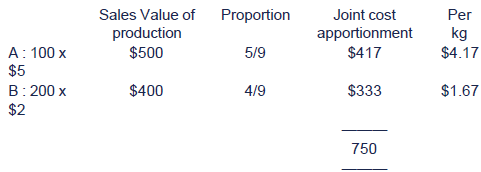
Trading results:

Note that the apportionment is on the basis of proportionate salesvalue of production; Profit per unit will be the same (with a smallrounding difference.)
(c) Apportionment by Net Realisable Value
This approach should be used in situations where the sales value atthe split-off point is not known - either because the product is notsaleable, or if the examiner does not tell us.
Further information is needed:

Apportionment of joint costs:
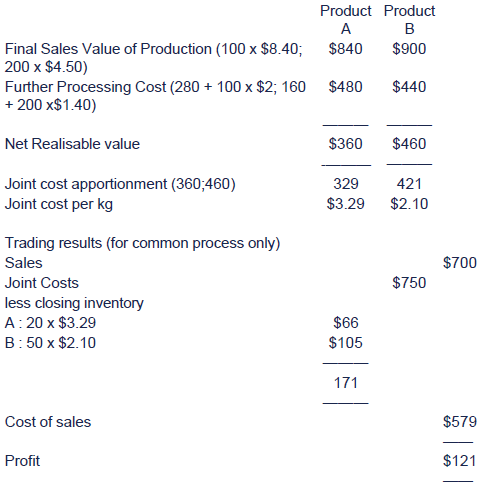


 Test your understanding 6
Test your understanding 6
The following is relevant for a production process for Period 1:

The process produces joint products A and B, which are then sold atthe prices given below. The output figure represents all of the outputfrom the process:

Required:
Calculate the cost of sales, and gross profit for products A and B assuming:
(i)joint costs are apportioned by market value;
(ii) joint costs are apportioned by production units.

Further processing decision
When deciding whether to process a product further or to sell aftersplit-off only future incremental cash flows should be considered:
- Any difference in revenue and any extra costs.
- Joint costs are sunk at this stage and thus not relevant to the decision.

 Test your understanding 7
Test your understanding 7
A firm makes three joint products, X, Y and Z, at a joint cost of$400,000. Joint costs are apportioned on the basis of weight. Products Xand Z are currently processed further.

An opportunity has arisen to sell all three products at the split-off point for the following prices.

Which of the products, if any, should the firm process further?

10 Chapter summary
Test your understanding answers

 Relevant costs
Relevant costs
(a)The salary is a relevant cost of£12,000. Do not be fooled by the mention of the fact that it is a fixedcost, it is a cost that is relevant to the decision to proceed with thefuture development of the new product. This is an example of a directlyattributable fixed cost. A directly attributable fixed cost may also becalled a product-specific fixed cost.
(b) The £2,500 additional running costsare relevant to the decision to purchase the new machine. The saving inoverhead absorption is not relevant since we are not told that thetotal overhead expenditure will be altered. The saving in labour costwould be relevant but we shall assume that this has been accounted forin determining the additional monthly running costs.
(c) This is not a relevant cost for nextmonth since it will be incurred even if the contract is cancelledtoday. If a decision is being made to close the office, this cost cannotbe included as a saving to be made next month. However, it will besaved in the months after that so it will become a relevant cost savingfrom month 2 onwards.
(d) This is not a relevant cost of thedecision to continue with the contract. The £75 is sunk and cannot berecovered even if the company does not proceed with the negotiations.


 Test your understanding 1 - Opportunity cost
Test your understanding 1 - Opportunity cost

Spare capacity amounts to 18,000 units. So there is sufficient slack to meet the new order.



 Test your understanding 2
Test your understanding 2

Robust Ltd should buy in component A since it would achieve savingsof $4 per unit or $6,000 pa. Buying in any of the other componentswould increase its costs.


 Test your understanding 3 - Additional question on make vs buy
Test your understanding 3 - Additional question on make vs buy
Annual internal processing costs
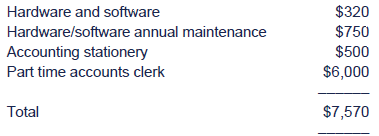
Annual outsourcing costs

It would not be cost effective to outsource the accounting activities. The present costs of $7,570 would rise to $8,100 pa
Qualitative factors include:
- predicted volumes - higher volumes will make outsourcing more expensive
- the quality of supply - will the external supplier make more errors?
- security of information.


 Test your understanding 4
Test your understanding 4
(a) First of all we must restate thefigures so that they present the situation in its true light. Onlyrelevant cash flows should be considered. This will enable eachdepartment to be readily evaluated on its locally controllableperformance.
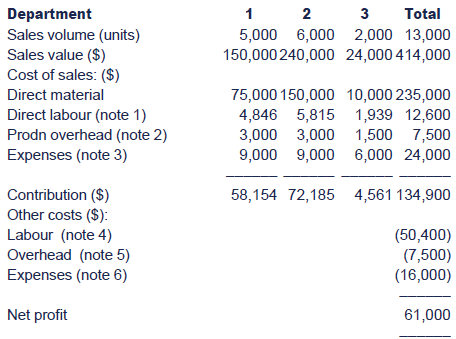
Notes
(1) 80% of the labour cost is fixedand is therefore excluded from the contribution calculation. Theremaining 20% has been allocated on the basis of sales volume.
(2) Only 50% of the production overheads can be directly allocated to the departments. This has been allocated in the ratio 2:2:1.
(3)Only 60% of the expenses can be directly traced to the departments. This has been allocated in the ratio 3:3:2.
(4) Fixed cost of labour is 80%.
(5) This is the remaining 50% of overheads that can't be allocated to departments.
(6) This is the remaining 40% of expenses that can't be allocated to departments.
Conclusion
From the restated figures department 3 should be kept open since:
- The department is making a contribution of $4,561 to the overall profit of the business.
- The apparent loss arises purely from inappropriate apportionment of overheads and expenses.
- If the department were closed:
- there would be a loss of $4,561 contribution to the business and
- on the assumption there would be no further saving on fixed costs, the profit would be reduced to $56,439.
(b) Consideration must be given to the following factors which may be non-quantifiable at present:
- Redundancy costs or costs relating to the disposal of equipment if department 3 is closed.
- The possible loss of business due to products from department 3 being unavailable to customers who buy from other departments at the same time.
- The reorganisation costs that may arise from the closure of department 3.
- Additional benefits of closure of department 3 such as labour and machinery being used to generate contribution elsewhere in the business.


 Test your understanding 5
Test your understanding 5
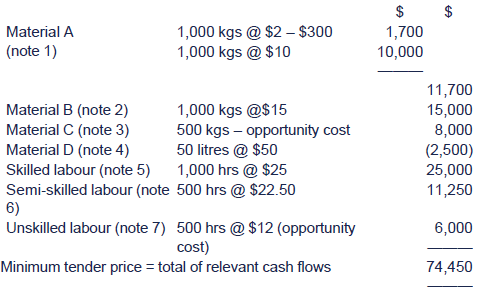
Notes
(1) There are 1,000 kgs in stock andthese will not be replaced. These would otherwise be sold at a net gainof $1,700. This gain is therefore foregone as a result of using thismaterial in the contract. The other 1,000 kgs are out of stock andtherefore the relevant cost is the current purchase price of $10 per kg.
(2) The material is in stock but will be replaced and therefore the relevant cost is the current purchase price of $15 per kg.
(3) The material is in stock and there are two options if this material is not used for the contract:
Option 1 – Sell it for $6,000.
Option 2 – Use it as a substitute and save $8,000.
Option 2 is preferable. This is therefore the opportunity cost of using it in the contract.
(4) The material is in stock and willnot be replaced. The cost of disposing of 50 litres will be saved (@$50/litre, i.e. $2,500). Saving this cost is a relevant benefit.
(5) The incremental cost of paying for the labour needed.
(6) 1,500 spare hours have already beenpaid for as the workforce are on annual contracts. The additional cashflow is therefore the extra 500 hours that are needed attime-and-a-half.
(7) For each hour diverted from theirnormal jobs contribution of $2 will be foregone. This together with thecost of paying the workers to do the project amounts to a relevant costof $12 per kg. They would not be hired at $20 per hour as this is moreexpensive.
(8) Fixed overheads can be ignored as they are not incremental.
(9) Costs of preparing the tender are all sunk costs and hence must be ignored.
(10) Profit element should be ignored since a minimum contract price is being calculated.


 Test your understanding 6
Test your understanding 6
(a) Market value basis

Working:

(b) Production units basis

Working:
Total output units = 2,000 + 8,000 = 10,000



 Test your understanding 7
Test your understanding 7
The pre-separation (i.e. “jointâ€) costs are not incremental andso can be ignored. The only incremental cash flows are as follows:

Thus only Z should be processed further.

|
Created at 5/24/2012 4:39 PM by System Account
(GMT) Greenwich Mean Time : Dublin, Edinburgh, Lisbon, London
|
Last modified at 5/25/2012 12:54 PM by System Account
(GMT) Greenwich Mean Time : Dublin, Edinburgh, Lisbon, London
|
|
|
|
 |
Rating
:
|
 Ratings & Comments
(Click the stars to rate the page) Ratings & Comments
(Click the stars to rate the page)
|
 |
Tags:
|
|
|
|
|